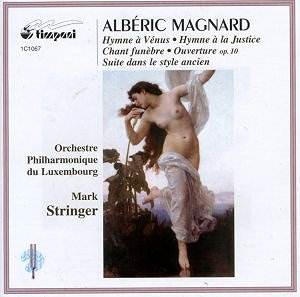There are three cycles of Magnard's four symphonies in the
catalogue. Those sets are by Sanderling (Bis), Ossonce (Hyperion) and
Plasson (EMI). The Plasson has been around the longest and is now in a
mid-price French EMI 3CD box. The other two are on two CDs each. The Plasson
is beginning to sound thin by comparison with the other two which are
from the late 1990s. This is a pity as Plasson has a tight grip on these
monuments to romantic determination. With these issues in the background
this gathering together of the other orchestral works was a natural
enough development.
The five pieces, each lasting between 10 and 15 minutes,
are serious late-romantic essays. There are two hymnes, a chant
(also recorded by Plasson as part of the 3CD set), a suite and an otherwise
non-specific ouverture. They date from the period 1889 to 1904,
taking as their temporal axle the turn of a century.
Magnard was much taken by the struggle for human rights,
Written in the stressed wake of the Dreyfus affair Hymne à
la Justice is a work of torment in which Brucknerian dress (Symphony
No. 8) and Schumann's manner (Overture, Scherzo and Finale) meet
a Franckian sensuality (7.22). It is that erotic deliquescence that
sighs and laps through the other Hymne à Venus written
two years after the Hymne à la Justice. This reminds the
listener of nothing so much as Franck's Psyché with a
rolling stormy turbulence that relates, probably unknowingly, to Suk's
contemporaneous Asrael.
The five movement Suite dans le style ancien
prepares the ground for pastiche re-inventions by Fauré
and Ravel. It may remind some of us of Parry's First Symphony and of
his English Suite. There were also moments when I thought of
Elgar's Bach and Handel orchestrations. The Chant funèbre
is dedicated to the 'memory of my father'. It is big-hearted
and romantic spirit streams out untiringly: protesting, resentful and
sorrowing. By a strange coincidence the recurrent tolling motif in the
horns (6.10) relates to a similarly funereal symphonic piece William
Alwyn's Hydriotaphia (Symphony No. 5). One can also, in this
music, see from where d'Indy (Symphonie Cévennole) and
Roussel (Symphony No. 1 Poème de la Forêt) drew
their creative material. The Ouverture is not quite the
Straussian 'blast' I was expecting. Its character is rather miscellaneous
and unresolved. Much of it is tense with shimmering expectation but
then comes some determined writing including recurrent gestures which
seem to predict Nielsen in his Third Symphony as at 00.34. At other
times the vivacious writing seems to refer to Dvořák's
Carnival and finally to the chaffing birdsong that ends
Bax's In the Faery Hills.
There is much pleasingly inventive writing in these
five works. Magnard was a surprising composer whose originality reaches
out from these scores. Another what if ... in this respect rather like
George Butterworth, Cecil Cole, Heinrich Bienstock and Rudi Stephan.
Each met death in the Great War.
Harry Halbreich's excellent notes grace this welcome
release which should not be missed by anyone favourably inclined towards
the surging late romantics. Enthusiastic playing from the Luxembourg
orchestra who under Mark Stringer's direction bring a perfervid conviction
to this music. Let us hope that the announced further Timpani collection
of music by Ropartz (Sur Les Chaumes and Chasse du Prince
Arthur amongst oither pieces) will be as good.
Rob Barnett
